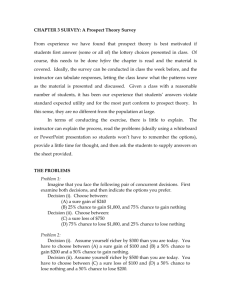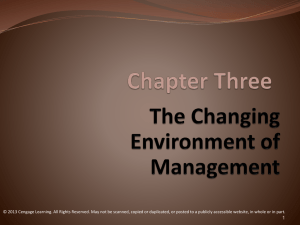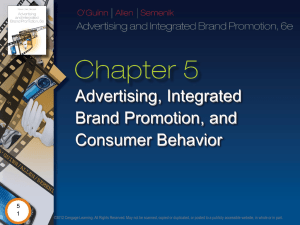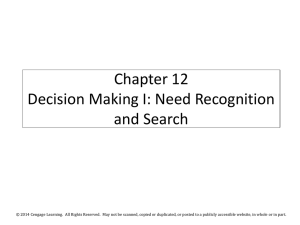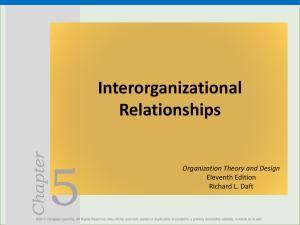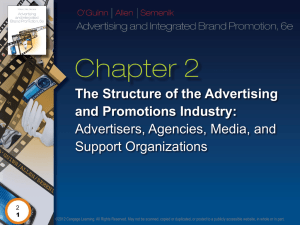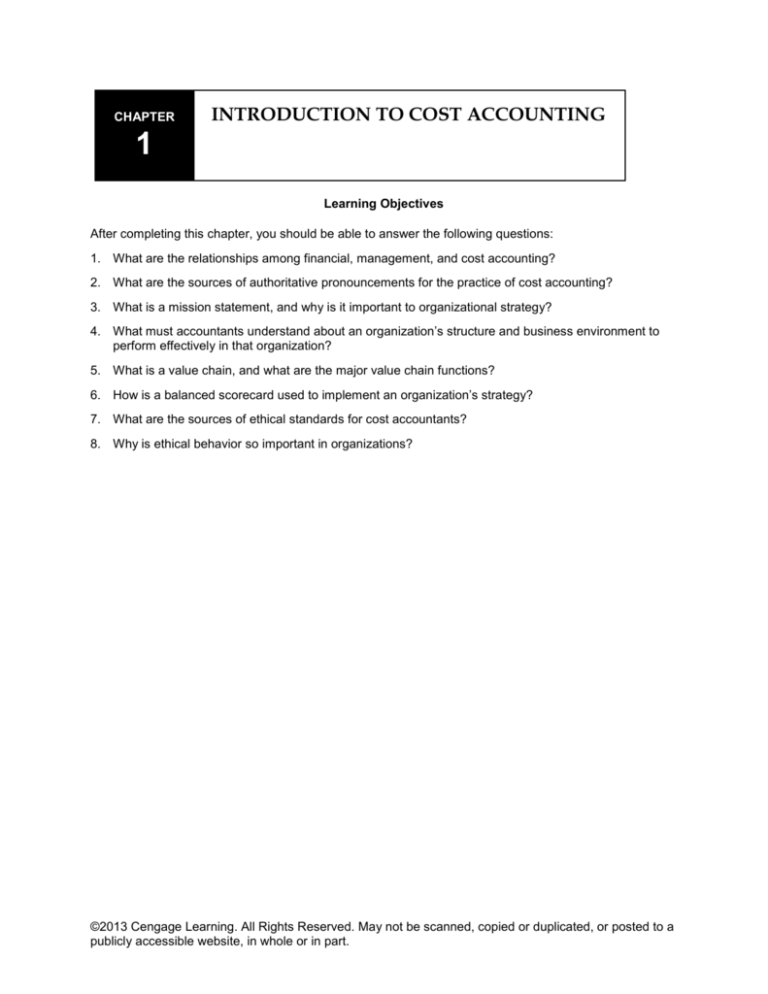
CHAPTER
INTRODUCTION TO COST ACCOUNTING
1
Learning Objectives
After completing this chapter, you should be able to answer the following questions:
1. What are the relationships among financial, management, and cost accounting?
2. What are the sources of authoritative pronouncements for the practice of cost accounting?
3. What is a mission statement, and why is it important to organizational strategy?
4. What must accountants understand about an organization’s structure and business environment to
perform effectively in that organization?
5. What is a value chain, and what are the major value chain functions?
6. How is a balanced scorecard used to implement an organization’s strategy?
7. What are the sources of ethical standards for cost accountants?
8. Why is ethical behavior so important in organizations?
©2013 Cengage Learning. All Rights Reserved. May not be scanned, copied or duplicated, or posted to a
publicly accessible website, in whole or in part.
Chapter 01: Introduction to Cost Accounting
IM 2
Terminology
Authority: The right (usually by virtue of position or rank) to use resources to accomplish a task or
achieve an objective
Balanced scorecard: A framework that restates an organization’s strategy into clear and objective
performance measures focused on customers, internal business processes, employees, and
shareholders
Competence: Professional ethics standard that requires professionals to develop and maintain the skills
needed to practice their profession
Confidentiality: Professional ethics standard that requires professionals to refrain from disclosing
company information to inappropriate parties (such as competitors)
Core competency: Any critical function or activity in which an organization seeks a higher proficiency
than its competitors, making it the root of competitiveness and competitive advantage
Cost accounting: A discipline that addresses the demands of both financial and management
accounting by providing product cost information to (1) external parties (stockholders, creditors, and
various regulatory bodies) for investment and credit decisions and (2) internal managers who are
responsible for planning, controlling, decision making, and evaluation of performance
Cost leadership: A company’s ability to maintain its competitive advantage by undercutting competitor
prices
Credibility: Professional ethics standard that requires individuals to provide full, fair, and timely
disclosure of all relevant information in a given situation
Customer value perspective: The balanced scorecard perspective that addresses how well the
organization is doing relative to important customer criteria such as speed (lead time), quality, service,
and price (both purchase and after purchase)
Downstream cost: Costs such as marketing, distribution, and customer service which are typically
incurred after production of the product as opposed to upstream costs of research and development and
product design
Earnings management: The act of using accounting methods or practices to deliberately “adjust” a
company’s profit amount to meet a predetermined internal or external target
Environmental constraint: any limitation caused by external cultural, fiscal (such as taxation structures),
legal/regulatory, or political situations and by the competitive market structures that cannot be directly
controlled by management
Financial performance perspective: The balanced scorecard perspective that addresses the concerns
of stockholders and other stakeholders about profitability and organizational growth
Integrity: Professional ethics standard that prohibits individuals from participating in activities that would
discredit their company or profession
Intellectual capital: All of the intangible assets contained in an organization, including knowledge, skills,
and information that are used to create ideas for products and services, to train and develop employees,
and to attract and retain customers
©2013 Cengage Learning. All Rights Reserved. May not be scanned, copied or duplicated, or posted to a
publicly accessible website, in whole or in part.
Chapter 01: Introduction to Cost Accounting
IM 3
Internal business perspective: The balanced scorecard perspective that addresses those things that
the organization needs to do well to meet customer needs and expectations
Lag indicator: Historical financial data or other outcomes resulting from past actions, such as installing a
new production process or implementing a new software system
Lead indicator: Future financial and non-financial outcomes including opportunities and problems that
help an organization assess strategic progress and guide decision making before lag indicators are
known
Learning and growth perspective: The balanced scorecard perspective that focuses on using the
organization’s intellectual capital to adapt to changing customer needs or to influence new customer
needs and expectations through product or service innovations
Line personnel: Employees who work directly toward attaining organizational goals. Line personnel
are often held responsible for achieving targeted balanced scorecard measures or budgeted operating
income for their divisions or geographic regions; examples would include managers in production, sales,
and distribution
Management accounting: That part of accounting that is concerned with providing information to parties
inside an organization so that they can plan, control operations, make decisions, and evaluate
performance
Mission statement: A written expression of organizational purpose that describes how the organization
uniquely meets its targeted customers’ needs with its products or services
Organizational structure: Reflects the way in which authority and responsibility for making decisions is
distributed in an organization
Product Cost: The sum of the costs incurred within the factory to make one unit of product
Product differentiation: A company’s ability to offer superior quality products or more unique services
than competitors; such products and services, generally, are sold at a premium price
Responsibility: The obligation to accomplish a task or achieve an objective
Return on investment (ROI): A measure calculated as net income divided by total assets which was
used historically to allocate resources and evaluate divisional performance
Service Cost: The sum of the direct costs incurred within a nonmanufacturing company or nonprofit
organization to provide a given service
Staff personnel: Employees who give assistance and advice to line personnel; examples include
employees in marketing, engineering, accounting, and finance
Strategy: The link between an organization’s goals and objectives and the activities actually conducted
by the organization
Upstream cost: Costs such as research and development and product design which are typically
incurred before production of the product as opposed to downstream costs of marketing, distribution, and
customer service
Value chain: The set of value-adding functions or processes that convert inputs into products and
services for the firm’s customers
©2013 Cengage Learning. All Rights Reserved. May not be scanned, copied or duplicated, or posted to a
publicly accessible website, in whole or in part.
Chapter 01: Introduction to Cost Accounting
IM 4
Lecture Outline
LO.1 What are the relationships among financial, management, and cost accounting?
A. Introduction
1. This chapter compares financial, management, and cost accounting, introduces the
organizational setting and environment in which the cost accountant must operate, and stresses
the importance of professional ethics.
B. Comparison of Financial, Management, and Cost Accounting
1. Financial Accounting
a. The objective of financial accounting is to provide useful information to external users of
financial statements including investors and creditors.
b. Financial accounting information is typically historical, quantitative, monetary, and verifiable
and usually reflects the activities of the whole organization.
c.
Financial accounting requires compliance with GAAP established by the FASB, the IASB,
and the SEC (or other influential organizations such as the APB and the AICPA).
i.
Publicly traded companies are required to have their financial statements audited by an
independent auditing firm.
ii.
Oversight of auditing standards for public companies is the responsibility of the Public
Company Accounting Oversight Board (PCAOB) which was created by the SarbanesOxley Act of 2002 (SOX) as a response to perceived abuses of accounting information by
corporate managers.
d. In the early 1900s, financial accounting was the dominant source of information for evaluating
business operations.
i.
ii.
Return on Investment (ROI) was one of the most popular performance measures:
ROI is calculated as Income divided by Total Assets.
ROI was a reasonable performance measure when companies were engaged in one
type of activity, operated primarily domestically, were labor intensive, and were
managed/owned by a small number of people.
As the securities market grew, so did the demand for audited financial statements.
The high cost of preparing financial reports due primarily to the lack of information
technology prevented organizations from developing a management accounting
system separate from the financial accounting system.
2. Management Accounting
a. Management accounting comprises the financial and nonfinancial information needed by
internal users (i.e., managers).
©2013 Cengage Learning. All Rights Reserved. May not be scanned, copied or duplicated, or posted to a
publicly accessible website, in whole or in part.
Chapter 01: Introduction to Cost Accounting
i.
IM 5
Managers are concerned with fulfilling corporate goals, communicating and implementing
strategy, and coordinating product design, production, and marketing while
simultaneously running distinct business segments.
b. Management accounting information is not required to adhere to GAAP and thus can provide
both historical and forward-looking information to managers.
i.
c.
Management accounting information commonly addresses individual or divisional
concerns rather than those of the firm as a whole.
By the mid-1900s, companies were operating in a globally competitive, multiple product
environment.
i.
Trying to manage by using only financial reporting information often created dysfunctional
behavior and thus led to the need and demand for a management accounting system.
ii.
Introduction of reasonably priced information technology greatly aided the cause.
The differences between financial and management accounting are summarized in text
Exhibit 1.1 (p. 3).
d. To prepare plans, evaluate performance, and make more complex decisions, management
needed forward looking information and information on the organization’s upstream and
downstream costs.
i.
When making pricing decisions, managers needed to add these upstream and
downstream costs to the GAAP-determined product cost as illustrated in Exhibit 1.2 (p.
4).
Upstream costs are costs such as research and development and product design
which are typically incurred before production of the product.
Downstream costs include costs such as marketing, distribution, and customer
service which are typically incurred after production of the product.
3. Cost Accounting
a. Cost accounting information addresses the demands of both financial and management
accounting and is thus represented as the intersection of the financial and management
accounting systems (See text Exhibit 1.3 (p. 4)).
i.
Cost accounting supports the financial accounting system by providing product cost and
service cost information to external parties (stockholders, creditors, and various
regulatory bodies) for investment and credit decisions.
For external reporting purposes, GAAP defines product cost as the sum of the costs
incurred within the factory to make one unit of product.
Service cost is the sum of the direct costs incurred within a nonmanufacturing
company or nonprofit organization to provide a given service.
©2013 Cengage Learning. All Rights Reserved. May not be scanned, copied or duplicated, or posted to a
publicly accessible website, in whole or in part.
Chapter 01: Introduction to Cost Accounting
ii.
IM 6
Cost accounting supports the management accounting system by providing product and
service cost information to internal managers who are responsible for planning,
controlling, decision making, and evaluating performance.
For internal reporting purposes, product and service cost information can be
developed outside the constraints of GAAP to assist management with specific
needs.
b. As companies expanded operations, managers recognized that a single cost could no longer
be computed for a product or service.
i.
For example, product costs could not easily be compared between multiple locations
when production processes were not similar in each location. Such complications
resulted in the evolution of the cost accounting database to include more than simply
financial accounting measures.
LO.2 What are the sources of authoritative pronouncements for the practice of cost accounting?
C. Cost Accounting Standards
1. The Institute of Management Accountants (IMA)
a. The IMA, a voluntary membership organization of accountants, finance specialists,
academics, and others, issues directives on the practice of management and cost
accounting.
i.
These directives, called Statements on Management Accounting (SMAs) are not legally
binding standards but they undergo a rigorous developmental and exposure process
that ensures wide support.
2. The Society of Management Accountants of Canada (CMA-Canada)
a. The IMA counterpart in Canada also issues guidelines on the practice of management
accounting called Management Accounting Guidelines (MAGs) and again, while not
mandatory, do represent best practices for high-quality organizational accounting.
3. The Cost Accounting Standards Board (CASB)
a. The CASB is a public sector body established in 1970 to issue uniform cost accounting
standards for defense contractors and federal agencies.
b. The CASB produced 20 cost accounting standards (one of which has been withdrawn) from
its inception until it was terminated in 1980.
c.
The CASB was recreated in 1988 as an independent board of the Office of Federal
Procurement Policy to help ensure uniformity and consistency in government contracting.
d. CASB standards do not constitute a comprehensive set of rules, but compliance is required
for companies bidding on or pricing cost-related contracts with the federal government.
4. No official agency publishes generic management accounting standards for all companies.
a. Although the IMA, CMA-Canada, and CASB have been instrumental in standards
development, much of the body of knowledge and practice in management accounting has
been provided by industry practice and economic and finance theory.
©2013 Cengage Learning. All Rights Reserved. May not be scanned, copied or duplicated, or posted to a
publicly accessible website, in whole or in part.
Chapter 01: Introduction to Cost Accounting
IM 7
LO.3 What is a mission statement and why is it important to organizational strategy?
D. Compteting in a Global Environment
1. General
a. A mission statement expresses the purposes for which the organization (whether for-profit
or not-for-profit) exists, what the organization wants to accomplish, and how its products and
services can uniquely meet its targeted customers’ needs.
b. Mission statements are used to develop the organization’s strategy or plan of how the firm
will fulfill its goals and objectives and achieve an advantage over its competitors.
2. Organizational Strategy (see text Exhibit 1.4 (p. 6))
a. A core competency is any critical function or activity such as technological innovation,
engineering, product development, and after-sale service in which an organization seeks a
higher proficiency than its competitors, making it the root of competitiveness and competitive
advantage.
b. Most companies compete using either a “cost leadership” or “product differentiation” strategy.
c.
i.
Cost leadership refers to a company’s ability to maintain its competitive edge by
undercutting competitor prices (e.g., Wal-Mart).
ii.
Product or service differentiation refers to a company’s ability to offer superior quality
products or more unique services than competitors; such products and services are,
however, generally sold at premium prices. (e.g., Rolex watches, BMW, etc.).
Cost accountants gather financial and nonfinancial information to help management achieve
organizational strategy. Text Exhibit 1.5 (p. 7) provides a checklist of questions that help
indicate whether an organization has a comprehensive strategy in place.
LO. 4 What must accountants understand about an organization’s structure and business
environment to perform effectively in that organization?
E. Organizational Structure
1. An organization is composed of people, resources other than people, and commitments that are
acquired and arranged to achieve organizational strategy and goals.
2. Organizational structure reflects the way in which authority and responsibility for making
decisions are distributed in an organization.
a. Authority refers to the right (usually by virtue of position or rank) to use resources to
accomplish a task or achieve an objective.
b. Responsibility is the obligation to accomplish a task or achieve an objective.
3. Work in organizations is directed by line personnel who work directly toward attaining
organizational goals, and staff personnel who give assistance and advice to line managers.
a. The treasurer is generally responsible for achieving short- and long-term financing, investing,
and cash management goals and is considered a staff position.
©2013 Cengage Learning. All Rights Reserved. May not be scanned, copied or duplicated, or posted to a
publicly accessible website, in whole or in part.
Chapter 01: Introduction to Cost Accounting
IM 8
b. The controller is responsible for delivering to management financial reports in conformity
with GAAP and is considered a staff position.
c.
The CFO is responsible for all financial activities of an organization and is considered a
member of line personnel.
4. Management style, the way managers interact with the entity’s stakeholders, especially
employees, impacts the organization’s decision-making processes, risk taking, willingness to
encourage change, and employee development.
5. Organizational culture refers to the basic manner in which the organization interacts with its
business environment, the way in which employees interact with each other and with
management, and the underlying beliefs and attitudes held by employees about the organization.
6. Short-term organizational constraints that may be overcome by existing business opportunities:
a. Monetary capital. If additional capital cannot be obtained at a reasonable cost management
must determine how to reallocate existing capital in an effective and efficient manner.
b. Intellectual capital, which encompasses the knowledge, skills, and information that an
organization possesses, impacts the firm’s ability to create ideas for products or services, to
train and develop its employees, and to attract and retain customers.
c.
Technology. Companies must adopt emerging technologies to stay at the top of their
industry and achieve a competitive advantage over competitors.
7. An environmental constraint is any limitation caused by external cultural, fiscal (such as
taxation structures), legal/regulatory, or political situations and by competitive market structures.
A cultural constraint becoming more prevalent is the effects of sustainability.
LO. 5 What is a value chain, and what are the major value chain functions?
F. Value Chain
1. The value chain is a set of value-adding functions or processes that convert inputs into products
and services for the organization’s customers (See text Exhibit 1.6 (p. 9)):
a. Research and Development—experimenting to reduce costs or improve quality.
b. Design—developing alternative product, service, or process designs.
c.
Supply—managing raw materials received from vendors to reduce costs and improve quality.
d. Production—acquiring and assembling resources to produce a product or render a service.
e. Marketing—promoting a product or service to current and prospective customers.
f.
Distribution—delivering a product or service to a customer.
g. Customer Service—supporting customers after the sale of a product or service.
2. Cost accountants help design the communication network that is used to communicate corporate
strategy to all members in the value chain so that the strategy can be effectively implemented.
©2013 Cengage Learning. All Rights Reserved. May not be scanned, copied or duplicated, or posted to a
publicly accessible website, in whole or in part.
Chapter 01: Introduction to Cost Accounting
IM 9
LO.6 How is a balanced scorecard used to implement an organization’s strategy?
G. Balanced Scorecard
1. Firms use a portfolio of lag and lead indicators to determine not only how the organization has
performed in the past but also how it is likely to perform in the future.
a. Lag indicators which are historical financial data that reflect outcomes that have resulted
from past actions, such as installing a new production process or implementing a new
software system, are often recognized and assessed too late to significantly improve current
or future actions.
b. Lead indicators which reflect future financial and nonfinancial outcomes (including
opportunities and problems) help managers assess strategic progress and guide decision
making before lag indicators are known.
2. Organizations often use both lead and lag indicators in a balanced scorecard to assess strategy
congruence.
3. The balanced scorecard (BSC) is a framework that restates an organization’s strategy into clear
and objective performance measures focused on customers, internal business processes,
employees, and shareholders.
4. The BSC includes long-term and short-term, internal and external, financial and nonfinancial
measures to balance management’s view and execution of strategy.
5. As illustrated in text Exhibit 1.7 (p. 11), the balanced scorecard has four perspectives:
a. The learning and growth perspective focuses on using the organization’s intellectual
capital to adapt to changing customer needs or to influence new customers’ needs and
expectations through product or service innovations.
b. The internal business perspective focuses on those things that the organization needs to
do well to meet customer needs and expectations.
c.
The customer value perspective addresses how well the organization is doing relative to
important customer criteria such as speed (lead time), quality, service, and price (both
purchase and after purchase).
d. The financial perspective addresses the concerns of stockholders and other stakeholders
about profitability and organizational growth.
6. See text Exhibit 1.8 (p. 12) for a more realistic and more complicated balanced scorecard.
LO.7 What are the sources of ethical standards for cost accountants?
H. Professional Ethics
1. Managers achieve their financial targets by concentrating on acquiring a targeted market
share and desired levels of customer satisfaction.
2. However, executives at some companies (e.g., WorldCom, Enron, Tyco, and HealthSouth)
have exhibited unethical behavior in trying to “make their numbers.”
©2013 Cengage Learning. All Rights Reserved. May not be scanned, copied or duplicated, or posted to a
publicly accessible website, in whole or in part.
Chapter 01: Introduction to Cost Accounting
IM 10
a. Earnings management involves using an accounting method or practice to deliberately
adjust a company’s profit amount to meet earnings estimates, preserve a specific
earnings trend, convert a loss to a profit, increase management compensation, or hide
illegal transactions, for example.
b. Aggressive Accounting involves exceeding the boundaries of reason in applying
accounting principles in order to meet a predetermined internal or external target.
3. The Sarbanes-Oxley Act of 2002 was passed to hold CEOs and CFOs personally
accountable for the accuracy of their organization’s financial reporting.
a. Under SOX, chief financial officers who knowingly certify false financial reports may be
punished with a maximum penalty of a $5 million fine, 20 years in prison, or both.
4. Certified Management Accountants (CMA) must adhere to the standards of ethical conduct
published in the Statement of Ethical Professional Practice issued by the IMA.
5. The IMA’s Code of Ethics (See text Exhibit 1.9 (pp. 13-14)) has four standards:
a. Competence means that individuals will develop and maintain the skills needed to
practice their profession.
b. Confidentiality means that individuals will refrain from disclosing company information to
inappropriate parties (such as competitors) that could be specifically defined in the
company’s code of ethics.
c.
Integrity means that individuals will not participate in activities that would discredit their
company or profession.
d. Credibility means providing full, fair, and timely disclosure of all relevant information.
6. Cost and management accountants who discover illegal or immoral behavior such as
financial fraud, theft, environmental violations, or employee discrimination should evaluate
the situation and, if appropriate, “blow the whistle” on the activities by disclosing them to
appropriate persons or agencies.
a. The accountant should keep the information confidential and report it to his/her
immediate supervisor (unless that person is suspected of being involved).
b. The accountant should continue up the chain of command to the first manager who is not
involved in the situation —meaning that it could be necessary to take the matter all the
way to the audit committee of the board of directors.
c.
If the matter cannot be resolved, the only recourse available may be to resign and consult
a legal adviser before reporting the matter to regulatory authorities.
d. In 2010, the Dodd-Frank Wall Street Reform and Consumer Protection Act was passed
with several provisions to encourage whistle-blowing.
LO.8 Why is ethical behavior so important in organizations?
I.
Ethics in Multinational Corporations
1. Accountants and other individuals working for multinational companies should be aware of not
only their company’s and the IMA’s code of ethical conduct but also the laws and ethical
©2013 Cengage Learning. All Rights Reserved. May not be scanned, copied or duplicated, or posted to a
publicly accessible website, in whole or in part.
Chapter 01: Introduction to Cost Accounting
IM 11
parameters within countries in which the multinational operates.
2. The Foreign Corrupt Practices Act (FCPA) of 1977 prohibits U.S. corporations from offering or
giving bribes (directly or indirectly) to foreign officials to influence those individuals (or cause them
to use their influence) to help businesses obtain or retain business. The FCPA was amended in
1998 to apply to foreign entities that make bribes within the United States.
3. The Organization of Economic Cooperation and Development (OECD) has released a document
that makes it a crime to offer, promise or give a bribe to a foreign public official in order to obtain
or retain international business deals.
a. As of July 2011, 39 countries (see Text Exhibit 1.10 (p. 16)) had signed this document,
including the United States.
b. Signing the OECD convention illustrates that companies globally are beginning to
acknowledge that bribery should not be considered an appropriate means of doing business.
©2013 Cengage Learning. All Rights Reserved. May not be scanned, copied or duplicated, or posted to a
publicly accessible website, in whole or in part.
Chapter 01: Introduction to Cost Accounting
IM 12
Multiple Choice Questions
1. (LO.1) Select the incorrect comparison between financial and management accounting:
a.
b.
c.
d.
Primary focus
Overriding criteria
Information timeframe
Recordkeeping
Financial Accounting
External
Verifiability
Historical
Formal
Management Accounting
Internal
GAAP
Current/future
Formal and informal
2. (LO.1) Oversight of auditing standards for public companies is the responsibility of the
a.
Public Company Accounting Oversight Board.
b.
Securities and Exchange Commission.
c.
Financial Accounting Standards Board.
d.
Institute of Management Accountants.
3, (LO.1) The acronym IASB stands for
a.
Internal Accounting Standards Board.
b.
Internal Auditing Standards Board.
c.
International Auditing Standards Board.
d.
International Accounting Standards Board.
4. (LO.1) Cost accounting can best be described as
a.
the intersection between financial and management accounting.
b.
a system that meets the informational demands of both financial and management
accounting.
c.
a system that provides product cost information to Internal managers for planning,
controlling, decision making and evaluating performance.
d.
all of the above.
5. (LO.2) Statements on Management Accounting (SMA) are directives on the practice of
management and cost accounting. Select the incorrect statement concerning SMAs from the
following.
a.
SMAs are issued by the Cost Accounting Standards Board.
b.
SMAs are not legally binding.
c.
SMAs go through a rigorous developmental and exposure process.
d.
SMAs describe high-quality or best practices in management accounting.
6. (LO.7) A management accountant who fails to perform professional duties in accordance with
relevant standards is acting contrary to which of the following standards?
a.
Competency
b.
Integrity
c.
Objectivity
d.
Confidentiality
7. (LO.7) The IMA Code of Ethics requires a management accountant to follow the established
policies of the organization when facing an ethical conflict. When management accountants fail
to resolve an ethical conflict by talking with their immediate supervisor they should
a.
communicate the problem to authorities outside the organization.
b.
contact the next higher managerial level.
c.
notify the audit committee of the board of directors.
d.
contact the chief financial officer.
©2013 Cengage Learning. All Rights Reserved. May not be scanned, copied or duplicated, or posted to a
publicly accessible website, in whole or in part.
Chapter 01: Introduction to Cost Accounting
IM 13
8. (LO.7) According to the IMA Code of Ethics a practitioner has the responsibility to recognize
professional limitations. Under which standard of ethical conduct would this responsibility be
included?
a.
Competency
b.
Confidentiality
c.
Integrity
d.
Objectivity
9. (LO.3) Strategic planning includes all of the following except:
a.
top-level management participation.
b.
a long-term focus.
c.
analysis of the current month’s actual variances from budget.
d.
identification of long-term key variables including external influences.
10. (LO.3) The strategy that is being used by a company that seeks to provide superior quality
products or more unique services than its competitors is a
a.
cost leadership strategy.
b.
differentiation strategy.
c.
customer value strategy.
d.
value chain strategy.
11. (LO.4) All of the following are staff personnel except:
a.
production supervisor.
b.
cost accountant.
c.
corporate controller.
d.
tax accountant.
12. (LO.4) An organization’s collection of knowledge, skills, and information is referred to as its
a.
political capital.
b.
qualitative capital.
c.
intangible capital.
d.
intellectual capital.
13. (LO.5) All of the following are examples of upstream functions in the value chain except
a.
supply.
b.
research and development.
c.
production.
d.
design.
14. (LO.6) Which balanced scorecard perspective focuses on those things that the organization must
do well to meet customer needs and expectations?
a.
Customer perspective
b.
Learning and growth perspective
c.
Financial perspective
d.
Internal business perspective
15. (LO.8) Which of the following is a violation of the Foreign Corrupt Practices Act?
a.
Paying cash bribes to foreign officials
b.
Giving sporting event tickets to foreign officials
c.
Providing free samples to the families of foreign officials
d.
All of the above
©2013 Cengage Learning. All Rights Reserved. May not be scanned, copied or duplicated, or posted to a
publicly accessible website, in whole or in part.
Chapter 01: Introduction to Cost Accounting
IM 14
Multiple Choice Solutions
1.
b
2.
a
3.
d
4.
d
5.
a
6.
a (CMA Adapted)
7.
b (CMA Adapted)
8.
c (CMA Adapted)
9.
c (CMA Adapted)
10.
b
11.
a
12.
d
13.
c
14.
d
15.
d
©2013 Cengage Learning. All Rights Reserved. May not be scanned, copied or duplicated, or posted to a
publicly accessible website, in whole or in part.



